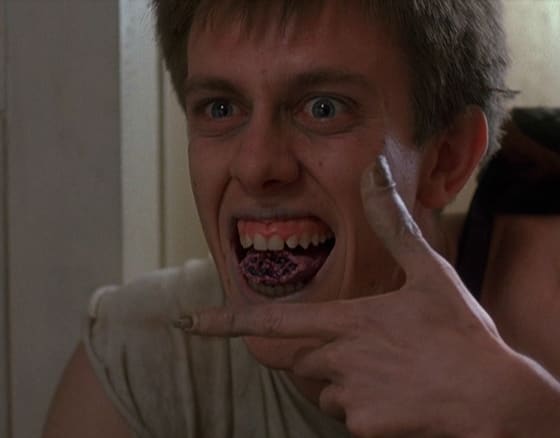When The People Under the Stairs was released, Wes Craven was a well-established horror director. The sixth Nightmare on Elm Street film had been released two months prior, and The Serpent and the Rainbow had fared surprisingly well critically and financially, having the crossover appeal that many of Craven's campier, fantastical works did not. His name alone had a modest, but reliable, box office draw, and his films consistently had the social self-consciousness and purpose; where other horror filmmakers were merely presenting the home invasion and quasi-religious horror that was selling at the time, Craven was analyzing the cultural purpose these films had while making them.
An early '90s advent influencing the appeal of this movie was the mainstream realization that marginalized voices had populist appeal. Many successful television programs and movies were featuring predominantly black casts, which was a shift from the status quo of the '80s, wherein the black on-screen representation was primarily Bill Cosby and Eddie Murphy appearing in programs that were primarily white.
Craven observed this cultural shift and addressed it. The People Under the Stairs starts out with a familiar premise and allows it to implode. 13-year-old Fool (Brandon Quintin Adams) accompanies Leroy (Ving Rhames) on a break and enter mission after learning that his uninsured mother is likely to die from cancer without some costly treatment. Also influencing his decision is the knowledge that his family is severely behind on their rent and will be evicted lest some finances are acquired promptly.
Their target is the large, highly secure home of the two adult siblings (Wendy Robie and Everett McGill, who were both coming off the success of Twin Peaks) that are coincidentally trying to evict Fool and his family so they can renovate the property and charge rich white people more money to live there.
Initially, the setup suggests basic conservative, xenophobic anxiety. The home invasion model was a popular cinematic trope at the time reinforcing the basic fears the middle and upper classes had of the lower class penetrating their lives and neighbourhoods. Craven turned this basic idea on its head, presenting a protagonist resorting to criminal behaviour as a last resort, targeting the very corporate financiers — here represented by two pseudo-incestuous psychopaths with a basement full of mutilated teenagers — that are indirectly threatening their culture and youth through gentrification and basic greed.
What's brilliant about this dark-humoured, extremely creative and twisted horror is that it doesn't present as the political piece that it ultimately is. Craven's eye for the macabre, and his intricate construction of a labyrinthine hell within the home of our antagonists, was so innovative and immersive that it would have succeeded as a superficial text about nothing. Fool's exploration of a house filled with secret passages and hidden booby-traps gives a sense of adventure to what's already an effectively grisly nightmare about two psychopaths in bondage gear ritualistically abusing and repressing children (their latest (AJ Langer), ultimately serves as an ally to Fool) when not eating human flesh or scheming ways to hoard money.
That they're cannibals whose mode of parental guidance is to beat subversion and irreverence out of a forming mind isn't an accident. Craven was stating something about class and race divisions that was otherwise being largely ignored, and given the time and the political climate surrounding its release, he was able to do so without being apologetic or fearful of misinterpretation. If someone were to make The People Under the Stairs now, there would be some anxiety about the presentation of racial difference and an inevitable, counterproductive move to simplify the issue with some well-intentioned but evasive political correctness. Stairs and the similarly masterful and underappreciated accompaniment piece, Candyman, didn't shy away from presenting complex characters making murky moral decisions to satisfy a need. These were films being made about the disparity between classes and, more often than not, races that used the fantastical as a metaphor for the unspoken fear existing in the underbelly of that dialogue.
This is discussed, in part, in the Wendy Robie interview included with the Shout! Factory release, but is otherwise left out of the discussion in other supplements about visual effects, the score, the cinematography and audio commentaries that are largely anecdotal. Still, the overall package is quite comprehensive for collectors, sharing an abundance of previously unknown production insights and factoids.
(Shout! Factory)An early '90s advent influencing the appeal of this movie was the mainstream realization that marginalized voices had populist appeal. Many successful television programs and movies were featuring predominantly black casts, which was a shift from the status quo of the '80s, wherein the black on-screen representation was primarily Bill Cosby and Eddie Murphy appearing in programs that were primarily white.
Craven observed this cultural shift and addressed it. The People Under the Stairs starts out with a familiar premise and allows it to implode. 13-year-old Fool (Brandon Quintin Adams) accompanies Leroy (Ving Rhames) on a break and enter mission after learning that his uninsured mother is likely to die from cancer without some costly treatment. Also influencing his decision is the knowledge that his family is severely behind on their rent and will be evicted lest some finances are acquired promptly.
Their target is the large, highly secure home of the two adult siblings (Wendy Robie and Everett McGill, who were both coming off the success of Twin Peaks) that are coincidentally trying to evict Fool and his family so they can renovate the property and charge rich white people more money to live there.
Initially, the setup suggests basic conservative, xenophobic anxiety. The home invasion model was a popular cinematic trope at the time reinforcing the basic fears the middle and upper classes had of the lower class penetrating their lives and neighbourhoods. Craven turned this basic idea on its head, presenting a protagonist resorting to criminal behaviour as a last resort, targeting the very corporate financiers — here represented by two pseudo-incestuous psychopaths with a basement full of mutilated teenagers — that are indirectly threatening their culture and youth through gentrification and basic greed.
What's brilliant about this dark-humoured, extremely creative and twisted horror is that it doesn't present as the political piece that it ultimately is. Craven's eye for the macabre, and his intricate construction of a labyrinthine hell within the home of our antagonists, was so innovative and immersive that it would have succeeded as a superficial text about nothing. Fool's exploration of a house filled with secret passages and hidden booby-traps gives a sense of adventure to what's already an effectively grisly nightmare about two psychopaths in bondage gear ritualistically abusing and repressing children (their latest (AJ Langer), ultimately serves as an ally to Fool) when not eating human flesh or scheming ways to hoard money.
That they're cannibals whose mode of parental guidance is to beat subversion and irreverence out of a forming mind isn't an accident. Craven was stating something about class and race divisions that was otherwise being largely ignored, and given the time and the political climate surrounding its release, he was able to do so without being apologetic or fearful of misinterpretation. If someone were to make The People Under the Stairs now, there would be some anxiety about the presentation of racial difference and an inevitable, counterproductive move to simplify the issue with some well-intentioned but evasive political correctness. Stairs and the similarly masterful and underappreciated accompaniment piece, Candyman, didn't shy away from presenting complex characters making murky moral decisions to satisfy a need. These were films being made about the disparity between classes and, more often than not, races that used the fantastical as a metaphor for the unspoken fear existing in the underbelly of that dialogue.
This is discussed, in part, in the Wendy Robie interview included with the Shout! Factory release, but is otherwise left out of the discussion in other supplements about visual effects, the score, the cinematography and audio commentaries that are largely anecdotal. Still, the overall package is quite comprehensive for collectors, sharing an abundance of previously unknown production insights and factoids.




